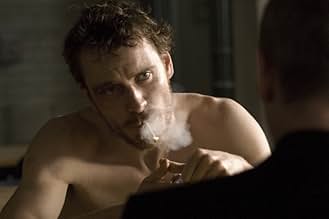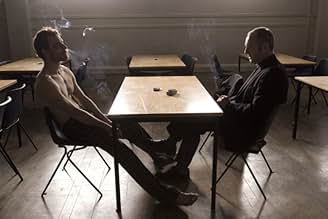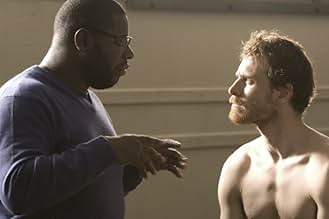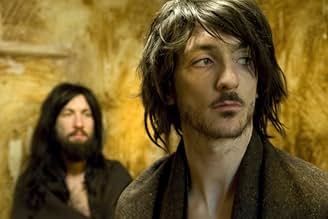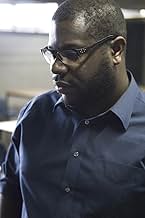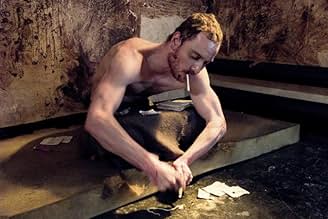Der irische Republikaner Bobby Sands führt die Häftlinge eines nordirischen Gefängnisses in einen Hungerstreik.Der irische Republikaner Bobby Sands führt die Häftlinge eines nordirischen Gefängnisses in einen Hungerstreik.Der irische Republikaner Bobby Sands führt die Häftlinge eines nordirischen Gefängnisses in einen Hungerstreik.
- Regie
- Drehbuch
- Hauptbesetzung
- 1 BAFTA Award gewonnen
- 49 Gewinne & 39 Nominierungen insgesamt
Empfohlene Bewertungen
Hunger (2008) ****
Bobby Sand's story has been told before on screen, but never with such raw intensity and unrelenting artistry as in Hunger. The film is directed by Turner Prize winning artist Steve McQueen. While his art has often been part of the film medium, this is his first entry into feature film-making.
The film sparked both controversy and applause at this years Cannes Film Festival, with both disgusted walkouts and rousing ovation. It the end it landed McQueen the Camera D'or.
While the film follows the final weeks of Bobby Sand's hunger strike, it is equally about recreating the atmosphere and conditions inside the infamous Long Kesh Maze Prison. Its nearly a half hour into the film before we even meet Sands, in fact. We're introduced to a prison guard, who outside nervously checks his car for bombs, quietly avoids his comrades, then becomes as vicious as any other when brutalizing the inmates. We're also first introduced to a new inmate, who, as per the IRA standard, refuses to war a uniform and instead goes simply wrapped in a blanket. He and his cellmate smear the walls of their cells in feces as part of the no wash protest.
Bobby is played by Michael Fassbender, who gives a quietly powerful performance. For the film he underwent a medically supervised crash diet, one rivaling - if not outright surpassing - that of Christian Bale in the Machinist. He moves throughout the film with a sense of determination and dedication.
It is difficult to go into any detail about plot, as the film more or less moves patiently and quietly towards the inevitable. And the key word may be quiet. McQueen claimed that he originally envisioned doing the film dialogue free. Indeed, much of Hunger is free of dialogue. However, McQueen, as he puts it, felt it would be more powerful to go from vocal silence into an avalanche of dialogue. And so the films centerpiece was born - a 20 minute stationary shot of Bobby speaking with his Priest. In a film that is filled with a dark heaviness in a cruel prison atmosphere, that meeting lifts a weight for a time, before slowly descending into a sad sense of inevitability. Though that inevitability is liberating, it is nonetheless a profoundly sad one. The film also does not shy away from the cruelty of the British towards the Irish, though it also does not deny the brutality of the IRA at times - as characterized in one shocking moment. However, anyone with any inkling of rational knowledge on the Irish struggles knows that the IRA was never simply a terrorist organization, but a rebel group that did from time to time employ terrorist tactics. Like all anti-state organizations, however, the IRA did not exist for the sake of conflict, but because of callousness and cruelty. McQueen reminds us of the cruelty and arrogance of the British particularly through the cold words of Margaret Thatcher, speaking shamelessly about Sands' strike.
There have been many fantastic films about the Irish Struggles, with some of the best coming in recent years (Ken Loach's fantastic Wind that Shakes the Barley, and Paul Greengrass's Bloody Sunday, to name two of the better). This one, I think, may be the best. At least from an artistic and purely visceral standpoint. McQueen captures his scenes in jarring compositions, with all the skill and artistic imagining of a true artist. From the opening sequences, Hunger promises something more than just the standard. Whereas most political films focus all their attention on the message, Hunger focuses on the feeling, and never strays from its artistic goals. This is art, from its opening to closing frames. It's a boldly crafted and brave film. The cinematography and direction are assured, moving slowly and unexpectedly, always beautifully even in its darkest and dirtiest moments.
I believe this truly is a great masterpiece. McQueen has proved himself as a masterful artist of film-making as well with Hunger.
Bobby Sand's story has been told before on screen, but never with such raw intensity and unrelenting artistry as in Hunger. The film is directed by Turner Prize winning artist Steve McQueen. While his art has often been part of the film medium, this is his first entry into feature film-making.
The film sparked both controversy and applause at this years Cannes Film Festival, with both disgusted walkouts and rousing ovation. It the end it landed McQueen the Camera D'or.
While the film follows the final weeks of Bobby Sand's hunger strike, it is equally about recreating the atmosphere and conditions inside the infamous Long Kesh Maze Prison. Its nearly a half hour into the film before we even meet Sands, in fact. We're introduced to a prison guard, who outside nervously checks his car for bombs, quietly avoids his comrades, then becomes as vicious as any other when brutalizing the inmates. We're also first introduced to a new inmate, who, as per the IRA standard, refuses to war a uniform and instead goes simply wrapped in a blanket. He and his cellmate smear the walls of their cells in feces as part of the no wash protest.
Bobby is played by Michael Fassbender, who gives a quietly powerful performance. For the film he underwent a medically supervised crash diet, one rivaling - if not outright surpassing - that of Christian Bale in the Machinist. He moves throughout the film with a sense of determination and dedication.
It is difficult to go into any detail about plot, as the film more or less moves patiently and quietly towards the inevitable. And the key word may be quiet. McQueen claimed that he originally envisioned doing the film dialogue free. Indeed, much of Hunger is free of dialogue. However, McQueen, as he puts it, felt it would be more powerful to go from vocal silence into an avalanche of dialogue. And so the films centerpiece was born - a 20 minute stationary shot of Bobby speaking with his Priest. In a film that is filled with a dark heaviness in a cruel prison atmosphere, that meeting lifts a weight for a time, before slowly descending into a sad sense of inevitability. Though that inevitability is liberating, it is nonetheless a profoundly sad one. The film also does not shy away from the cruelty of the British towards the Irish, though it also does not deny the brutality of the IRA at times - as characterized in one shocking moment. However, anyone with any inkling of rational knowledge on the Irish struggles knows that the IRA was never simply a terrorist organization, but a rebel group that did from time to time employ terrorist tactics. Like all anti-state organizations, however, the IRA did not exist for the sake of conflict, but because of callousness and cruelty. McQueen reminds us of the cruelty and arrogance of the British particularly through the cold words of Margaret Thatcher, speaking shamelessly about Sands' strike.
There have been many fantastic films about the Irish Struggles, with some of the best coming in recent years (Ken Loach's fantastic Wind that Shakes the Barley, and Paul Greengrass's Bloody Sunday, to name two of the better). This one, I think, may be the best. At least from an artistic and purely visceral standpoint. McQueen captures his scenes in jarring compositions, with all the skill and artistic imagining of a true artist. From the opening sequences, Hunger promises something more than just the standard. Whereas most political films focus all their attention on the message, Hunger focuses on the feeling, and never strays from its artistic goals. This is art, from its opening to closing frames. It's a boldly crafted and brave film. The cinematography and direction are assured, moving slowly and unexpectedly, always beautifully even in its darkest and dirtiest moments.
I believe this truly is a great masterpiece. McQueen has proved himself as a masterful artist of film-making as well with Hunger.
Steve McQueen, a noted young British artist, has made a powerful first film about the Irish prisoners in H-Block of Maze Prison, Northern Ireland, and the hunger strike and death of Bobby Sands in 1981. The images are searing, both horrible and beautiful (McQueen is aware from Goya that images of war can be both), and much of the film is non-verbal, but the action is broken up by a centerpiece tour-de-force debate between Sands (Michael Fassbender) and Father Dominic Moran (Liam Cunningham) that is as intensely verbal as the rest is wordless. In Irish playwright Enda Walsh's rapid-fire dialogue quips are exchanged, then passionate declarations, in a duel that's like a killer tennis match: watching, we listen, and the camera, hitherto ceaselessly in motion, becomes still. Hunger, with its rich language, intense images, and devastating story, is surely one of the best English-language of the year, and it understandably won the Camera d'Or at Cannes for the best first film. Like the American Julian Schnabel, Steve McQueen is another visual artist who has turned out to be an astonishingly good filmmaker.
Faithful to the physical details of the H-blocks and the treatment of the prisoners, the film is still honed down to essentials and includes a series of sequences so intense it may take viewers a long time to digest them. As the film opens, an officer of the prison, Raymond Lohan (Stuart Graham), follows his normal routine. His knuckles are bloody and painful; later we learn why. His wife brings him sausage, rasher, and eggs.
Davey Gillen (Brian Milligan) a young Irish republican prisoner, tall, gaunt, and Christ-like, is brought into the prison. He refuses to wear the prison uniform, so, joining the Blanket protest, he's put in with fellow "non-conforming" prisoner Gerry Campbell (Liam McMahon) in a cell whose walls are smeared with feces. Those of us who were around when these events happened (Steve McQueen was 12, and remembers the coverage), remember them so well we could have seen these walls. Campbell shows Gillen hot to receive "comms" (communications) from visitors and pass them to their leader Bobby Sands at Sunday mass.
When prisoners agree to wear civilian garments, they're mocked by the "clown clothes" they're handed out and riot, screaming and yelling and tearing up everything in their cells. They also periodically collect their urine and pour it under their cell doors out into the prison hallway where the guards must walk. The result is a brutal punishment by the prison in which the prisoners are taken out to the hallway and beaten naked by a gauntlet of police in riot gear. An eventual repercussion is that Raymond Lohan is shot dead while visiting his catatonic mother in a home.
A poetic flourish of the meeting between Sands and Father Moran is Sands's story of going to the country as a Belfast boy on the cross country team and going down to a woods and a stream where he is the only one who dares to put a dying foal out of its misery by drowning it. The images this tale evoke become the objective correlative of Bobby's last thoughts when he is dying in the prison hospital.
The central issue was being treated as political prisoners. From 1972, paramilitary prisoners had held some of the rights of prisoners of war. This ended in March 1976 and the republican prisoners were sent to the new Maze Prison and its "H-blocks" near Belfast. Special Category Status for prisoners convicted of terrorist crimes was abolished by the English government. Hunger doesn't focus on ideology or public policy, other than to have the voice of Margaret Thatcher, in several orotund declarations, adamantly denying the validity of the republicans' cause or status. The Sands-Moran debate is more about feelings and tactics.
Another powerful contrast comes when Sand goes on the hunger strike and is taken to the clean, quiet setting of the hospital where he is lovingly cared for and visited by a good friend and his parents, who're even allowed to sleep there during his last days. Sands' condition is dramatic, heightened by horrible sores, and a report to his parents of the rapid damage to internal organs and heart that his fast will cause.
It was McQueen's decision to eschew a screenwriter in favor of a playwright for the script, and his choice of his near-contemporary Enda Walsh, an Irishman resident in London, was a wise one. McQueen determined the structure and inspired the paring down. Walsh makes the central verbal scene sing. Its intensity is such that it has no trouble at all competing with the harsh prison scenes. It is brilliant stroke. Great theater you could say, but the film's contribution is to make the whole train of events alive and human at a time when they are acutely relevant to the post 9/11 world of Guantanamo and Abu Ghraib.
Shown at Cannes, Telluride, and Toronto, included in the New York Film Festival 2008.
Faithful to the physical details of the H-blocks and the treatment of the prisoners, the film is still honed down to essentials and includes a series of sequences so intense it may take viewers a long time to digest them. As the film opens, an officer of the prison, Raymond Lohan (Stuart Graham), follows his normal routine. His knuckles are bloody and painful; later we learn why. His wife brings him sausage, rasher, and eggs.
Davey Gillen (Brian Milligan) a young Irish republican prisoner, tall, gaunt, and Christ-like, is brought into the prison. He refuses to wear the prison uniform, so, joining the Blanket protest, he's put in with fellow "non-conforming" prisoner Gerry Campbell (Liam McMahon) in a cell whose walls are smeared with feces. Those of us who were around when these events happened (Steve McQueen was 12, and remembers the coverage), remember them so well we could have seen these walls. Campbell shows Gillen hot to receive "comms" (communications) from visitors and pass them to their leader Bobby Sands at Sunday mass.
When prisoners agree to wear civilian garments, they're mocked by the "clown clothes" they're handed out and riot, screaming and yelling and tearing up everything in their cells. They also periodically collect their urine and pour it under their cell doors out into the prison hallway where the guards must walk. The result is a brutal punishment by the prison in which the prisoners are taken out to the hallway and beaten naked by a gauntlet of police in riot gear. An eventual repercussion is that Raymond Lohan is shot dead while visiting his catatonic mother in a home.
A poetic flourish of the meeting between Sands and Father Moran is Sands's story of going to the country as a Belfast boy on the cross country team and going down to a woods and a stream where he is the only one who dares to put a dying foal out of its misery by drowning it. The images this tale evoke become the objective correlative of Bobby's last thoughts when he is dying in the prison hospital.
The central issue was being treated as political prisoners. From 1972, paramilitary prisoners had held some of the rights of prisoners of war. This ended in March 1976 and the republican prisoners were sent to the new Maze Prison and its "H-blocks" near Belfast. Special Category Status for prisoners convicted of terrorist crimes was abolished by the English government. Hunger doesn't focus on ideology or public policy, other than to have the voice of Margaret Thatcher, in several orotund declarations, adamantly denying the validity of the republicans' cause or status. The Sands-Moran debate is more about feelings and tactics.
Another powerful contrast comes when Sand goes on the hunger strike and is taken to the clean, quiet setting of the hospital where he is lovingly cared for and visited by a good friend and his parents, who're even allowed to sleep there during his last days. Sands' condition is dramatic, heightened by horrible sores, and a report to his parents of the rapid damage to internal organs and heart that his fast will cause.
It was McQueen's decision to eschew a screenwriter in favor of a playwright for the script, and his choice of his near-contemporary Enda Walsh, an Irishman resident in London, was a wise one. McQueen determined the structure and inspired the paring down. Walsh makes the central verbal scene sing. Its intensity is such that it has no trouble at all competing with the harsh prison scenes. It is brilliant stroke. Great theater you could say, but the film's contribution is to make the whole train of events alive and human at a time when they are acutely relevant to the post 9/11 world of Guantanamo and Abu Ghraib.
Shown at Cannes, Telluride, and Toronto, included in the New York Film Festival 2008.
1981.
The H block in Belfast's Maze Prison.
This film captures the development and escalation of protest by the 'political' prisoners held here as things moved through 'The 'Blanket protest' onto 'The Dirty Protest" and finally to 'The Hunger Strikes' that claimed Bobby Sands and eight of his compatriot's lives.
As the end credits of the film show, the enemy, in the form of Margaret Thatcher was 'not for turning' and did not grant political status to these men that she considered no more than murderers. They did, however, lead to many concessions - bit by bit.
This astounding movie falls into three very clear sections; the gut wrenching blanket and dirty protest; a long and deeply personal conversation (in one 20 minute take) between Sands and his priest where Sands is asked to justify and then walk away from the impending hunger strike; and finally Sands' ordeal itself.
Each section has a different pace and personality. Each is desperate in its own way.
This film pulls few punches. The stench of human excrement is almost palpable in the opening act and the way in which Michael Fassbender brings Sands' death to the screen is almost unbearable.
But the real triumph of the film is that it takes no political sides and makes no judgements but does not sit on the fence. How? Because it invokes the viewer to do that themselves. Sands is neither a figure to pity or to vilify. It really is quite remarkable that the artist Steve McQueen can achieve this so consistently.
And this is art with a capital A. Every scene is stunningly rendered. The pace, at times snail-like, allows you consider in real detail the situation these men found themselves in (or created however you want to look at it).
Fassbender's performance is miraculous.
McQueen though, is the star of the show. One scene in particular when the men slop out by pouring their night's urine under the doors of the corridor simultaneously is quite beautiful, as is the Hirst-like art that some of them create from their excrement (that's what makes up the poster image).
Film of the year. No contest.
Incidentally we saw it in the DCA's Cinema 2. What a cracking screen.
(As we scoffed coffee and fudge doughnuts. How's that for irony?)
The H block in Belfast's Maze Prison.
This film captures the development and escalation of protest by the 'political' prisoners held here as things moved through 'The 'Blanket protest' onto 'The Dirty Protest" and finally to 'The Hunger Strikes' that claimed Bobby Sands and eight of his compatriot's lives.
As the end credits of the film show, the enemy, in the form of Margaret Thatcher was 'not for turning' and did not grant political status to these men that she considered no more than murderers. They did, however, lead to many concessions - bit by bit.
This astounding movie falls into three very clear sections; the gut wrenching blanket and dirty protest; a long and deeply personal conversation (in one 20 minute take) between Sands and his priest where Sands is asked to justify and then walk away from the impending hunger strike; and finally Sands' ordeal itself.
Each section has a different pace and personality. Each is desperate in its own way.
This film pulls few punches. The stench of human excrement is almost palpable in the opening act and the way in which Michael Fassbender brings Sands' death to the screen is almost unbearable.
But the real triumph of the film is that it takes no political sides and makes no judgements but does not sit on the fence. How? Because it invokes the viewer to do that themselves. Sands is neither a figure to pity or to vilify. It really is quite remarkable that the artist Steve McQueen can achieve this so consistently.
And this is art with a capital A. Every scene is stunningly rendered. The pace, at times snail-like, allows you consider in real detail the situation these men found themselves in (or created however you want to look at it).
Fassbender's performance is miraculous.
McQueen though, is the star of the show. One scene in particular when the men slop out by pouring their night's urine under the doors of the corridor simultaneously is quite beautiful, as is the Hirst-like art that some of them create from their excrement (that's what makes up the poster image).
Film of the year. No contest.
Incidentally we saw it in the DCA's Cinema 2. What a cracking screen.
(As we scoffed coffee and fudge doughnuts. How's that for irony?)
Hunger is a low budget film from a production company more recognisable for its TV work, without any recognisable stars, without a really big distributer to get it around and directed by a Turner Prize winning visual artist making his film debut. Already you would perhaps be considering giving it a miss and maybe this isn't the best time to mention it is a largely dialogue free account of hunger-striker Bobby Sands set entirely in Northern Ireland's infamous Maze prison. This is probably one of the reasons that the film hasn't been as widely seen as it deserves to be or why audiences haven't flocked into screenings of it on a Saturday night. Certainly it is not an easy watch given the subject matter alone but yet it is a compelling and quite brilliant film.
Although the nature of the story leads the viewer to be emotionally invested in one "side" of the situation, McQueen never does anything that opens his film to this suggestion of bias or of scoring political points, if anything his attention to the detail of the tightly focused story does just the opposite. As well as telling us how many hunger strikers died, he point out how many prison guards were murdered during the period and, in my favourite part, introduces us to the prison via one guard soothing his hands (which tells us the frequency of what he does). It is a nice moment but not as telling as the thrill the viewer gets as he checks for bombs and starts his car we are supposed to be on the edge of our seat and we are, swiftly followed by the realisation that this is an experience we would repeat if we were in his driveway the next day or the next.
From here we move into a nearly dialogue free thirty minute opening where no central character really comes forward and our "focus" is on life in the prison for guards and prisoners a story that almost starts without there being a "story". The film later brings Bobby Sands to the fore, delivering one impressive dialogue scene before returning to a dialogue-light charting of his hunger strike on the way to the conclusion that we all know is coming. Yet it manages to be really engaging because of the level of each detail in each scene and the relevance of each scene to the overall film. The scene that has gotten all the mentions and praise is the long dialogue scene between Sands and the priest who comes to see him before his strike. Filmed in three distinct shots, the scene is technically impressive but also allows the main dialogue delivery of the film and the only really moment where anyone is allowed to debate and discuss the actions. Even here McQueen does not allow sides to be taken but keeps it as two men talking. It is engaging, really well written and of course, really well acted.
It is ironic that in this scene the film sits still for ages and allows the frame to remain the same because for the majority of the film McQueen's camera is the star. So many shots are striking that it almost becomes "normal" to be transfixed by an image on the screen. Whether it be a excrement-smeared cell, urine flowing down a hall or a man washing blood from his hands, it looks great and the care taken to construct each image fills the "gap" that the dialogue leaves. The performances are mostly very good and compliment the "few words" approach by bringing a lot when required and wearing their characters convincingly. There are some you may recognise but I didn't. Fassbender is the most memorable as he has the biggest character and the most startling journey, but this should not take away from smaller turns from Graham, Mullen and a few others who are also good. The film is not perfect though. The uninitiated may struggle to understand the bigger picture as you don't get a lot of help with that and those that don't get into the telling initially may be left cold by the approach. However these "weaknesses" are not missed targets or failings but rather the "cons" that have to come with the overwhelming pros of the manner of delivery.
Hunger is not an easy film to watch but it is a great film. It is wonderfully shot with an artist's composure but McQueen is not a "visual style" director who doesn't come with anything else (list your own failed music video director turned film director here) but rather he uses this approach to improve the film and make the telling better. The acting is impressive because of how real they feel and how little dialogue they have across the whole film, but to me the real star was McQueen. He is a visual artist and it shows as he makes the majority of his shots striking and engaging, even if they are not "beautiful". It may get a bit more exposure due to awards chatter but even if it doesn't it is certainly worth checking out.
Although the nature of the story leads the viewer to be emotionally invested in one "side" of the situation, McQueen never does anything that opens his film to this suggestion of bias or of scoring political points, if anything his attention to the detail of the tightly focused story does just the opposite. As well as telling us how many hunger strikers died, he point out how many prison guards were murdered during the period and, in my favourite part, introduces us to the prison via one guard soothing his hands (which tells us the frequency of what he does). It is a nice moment but not as telling as the thrill the viewer gets as he checks for bombs and starts his car we are supposed to be on the edge of our seat and we are, swiftly followed by the realisation that this is an experience we would repeat if we were in his driveway the next day or the next.
From here we move into a nearly dialogue free thirty minute opening where no central character really comes forward and our "focus" is on life in the prison for guards and prisoners a story that almost starts without there being a "story". The film later brings Bobby Sands to the fore, delivering one impressive dialogue scene before returning to a dialogue-light charting of his hunger strike on the way to the conclusion that we all know is coming. Yet it manages to be really engaging because of the level of each detail in each scene and the relevance of each scene to the overall film. The scene that has gotten all the mentions and praise is the long dialogue scene between Sands and the priest who comes to see him before his strike. Filmed in three distinct shots, the scene is technically impressive but also allows the main dialogue delivery of the film and the only really moment where anyone is allowed to debate and discuss the actions. Even here McQueen does not allow sides to be taken but keeps it as two men talking. It is engaging, really well written and of course, really well acted.
It is ironic that in this scene the film sits still for ages and allows the frame to remain the same because for the majority of the film McQueen's camera is the star. So many shots are striking that it almost becomes "normal" to be transfixed by an image on the screen. Whether it be a excrement-smeared cell, urine flowing down a hall or a man washing blood from his hands, it looks great and the care taken to construct each image fills the "gap" that the dialogue leaves. The performances are mostly very good and compliment the "few words" approach by bringing a lot when required and wearing their characters convincingly. There are some you may recognise but I didn't. Fassbender is the most memorable as he has the biggest character and the most startling journey, but this should not take away from smaller turns from Graham, Mullen and a few others who are also good. The film is not perfect though. The uninitiated may struggle to understand the bigger picture as you don't get a lot of help with that and those that don't get into the telling initially may be left cold by the approach. However these "weaknesses" are not missed targets or failings but rather the "cons" that have to come with the overwhelming pros of the manner of delivery.
Hunger is not an easy film to watch but it is a great film. It is wonderfully shot with an artist's composure but McQueen is not a "visual style" director who doesn't come with anything else (list your own failed music video director turned film director here) but rather he uses this approach to improve the film and make the telling better. The acting is impressive because of how real they feel and how little dialogue they have across the whole film, but to me the real star was McQueen. He is a visual artist and it shows as he makes the majority of his shots striking and engaging, even if they are not "beautiful". It may get a bit more exposure due to awards chatter but even if it doesn't it is certainly worth checking out.
It's 1981. Raymond Lohan (Stuart Graham) is a guard in the Maze Prison, Northern Ireland. Davey Gillen is a new IRA prisoner who refuses to wear prison uniforms. He's put in with Gerry who has smeared the cell with his own feces. They smuggle things in and out of the prison. Bobby Sands (Michael Fassbender) leads the prisoners in a hunger strike.
It's quiet film and full of little details. It doesn't wallow in the brutality but lets it envelop the movie. There is a realism in the movie that is more powerful than any flash or action sequence. One really gets the sense of dehumanization. Dialog is sparse but there is a great discussion between Sands and Father Dominic Moran. This is quietly brutal and some great performances including Fassbender.
It's quiet film and full of little details. It doesn't wallow in the brutality but lets it envelop the movie. There is a realism in the movie that is more powerful than any flash or action sequence. One really gets the sense of dehumanization. Dialog is sparse but there is a great discussion between Sands and Father Dominic Moran. This is quietly brutal and some great performances including Fassbender.
Wusstest du schon
- WissenswertesHunger is known for its unbroken 17 minute 10 second continuous shot, in which Catholic priest Father Dominic Moran tries to talk Bobby Sands out of the Hunger Strike he and his fellow 75 IRA members plan to start. The camera remains in the same position throughout the scene. To prepare, Liam Cunningham moved into Michael Fassbender's apartment, and they rehearsed the scene 12-15 times per day. On the first day of filming, the actors got it perfect after 4 takes.
- PatzerThatcher's speech that says "the men of violence have chosen in recent months to play what may well be their last card" is shown in the film when the hunger strike is beginning, but it was actually made after Bobby Sands had died. It was made on 28th May 1981. Bobby Sands died on 5th May 1981.
- Zitate
Bobby Sands: I have my belief, and in all its simplicity that is the most powerful thing.
- VerbindungenFeatured in Front Row: Michael Fassbender/Kate Winslet (2017)
- SoundtracksIndustry
Performed by Maya Beiser
Composed by Michael Gordon
Published by Red Poppy in association with G. Schirmir, Inc.
Top-Auswahl
Melde dich zum Bewerten an und greife auf die Watchlist für personalisierte Empfehlungen zu.
Details
- Erscheinungsdatum
- Herkunftsländer
- Offizieller Standort
- Sprachen
- Auch bekannt als
- Tù Khổ Sai
- Drehorte
- Produktionsfirmen
- Weitere beteiligte Unternehmen bei IMDbPro anzeigen
Box Office
- Budget
- 1.500.000 £ (geschätzt)
- Bruttoertrag in den USA und Kanada
- 154.084 $
- Eröffnungswochenende in den USA und in Kanada
- 1.980 $
- 7. Dez. 2008
- Weltweiter Bruttoertrag
- 3.185.113 $
- Laufzeit
- 1 Std. 36 Min.(96 min)
- Farbe
- Sound-Mix
- Seitenverhältnis
- 2.35 : 1
Zu dieser Seite beitragen
Bearbeitung vorschlagen oder fehlenden Inhalt hinzufügen




